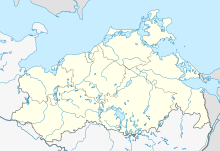Forkenbeck
Coordinates: 54 ° 10 ' N , 12 ° 42' E
Forkenbeck is a district of the municipality Eixen in the district of Vorpommern-Rügen in the north of Mecklenburg-Western Pomerania .
geography
The village of Eixen is located between Semlow and Eixen on Landesstraße 22 and between Bisdorf and Ravenhorst. The village is nestled between numerous fields and meadows. In the direction of Ravenhorst there is a large piece of forest that extends as far as Schlemmin . The Eixener See is also nearby .
history
As early as the 10th century, Vorkonbikie can be found in the collection register of the Freckenhorst Monastery: from there a Geba (Gebhard) has to deliver "two times ground barley" every year. The village of Forkenbeck in Westphalia , which today belongs to the town of Warendorf in the Münsterland , is mentioned in a document again in 1226. Knight Arnoldus de Vorkenbeke, who went to the Principality of Rügen, comes from this village. Arnoldus' widow and their sons Johannes and Reynolt ceded their claims to a hoof in Brandshagen in 1284 . In 1310 Hinricus Vorkenbeke was ostracized in Stralsund . The family does not continue to appear afterwards.
It is possible that this family developed into the von Forckenbeck family, from which Berlin mayor Max von Forckenbeck also came. Hinricus VI acquired in 1320 and 1321. from the Hagen income in Forkenbeck and surrounding villages.
The von Hagens owned the village until 1370, then sold it to the von Behr family , Neuhofer Line, until they died out in 1560. The lineages of the von Behr, Nustrow-Semlow and Hugoldsdorf families argued about it, and in the end the Hugoldsdorf family won. These divided the village. Part of the planned 1603 to the Semlower line, the remaining part in 1636. When Christoph von Behr died in Semlow in 1650 , Forkenbeck was given to his daughter Anna, who was married to Otto von Thun in Schlemmin . It passed from the von Thun family to the von Normann family . In 1704 the village came back to the von Behr family in Semlow. In 1696 there were 8 families in the village. In 1802 Forkenbeck was owned by the von Behr-Negendank family on Semlow . In 1862, Herr von Behr-Negendank, Grand Ducal Mecklenburg Chamberlain on Passow near Lübz, was the owner of Forkenbeck, Kavelsdorf and Ravenhorst. These villages formed a Fideikommiss since 1785 .
There are two burial mounds in front of the village church of Semlow . Georg Fürstenow († 1869) rests with his wife Louise, b. Behringer. The grave slab identifies him as a tenant at Forkenbeck.
The village was settled in the 20th century. On the road between Semlow and Eixen as well as to Bisdorf, a number of new farmer positions were created in the 1920s. The settlers came from southern and western Germany. Until then, the old village consisted only of the estate around the village pond and the houses on the village road and the forester's house by the Kesselsaal. After the end of the war, refugees and others came. a. from Galicia here. After the land reform , the land could be redistributed. In 1952 the LPG Rosa Luxemburg (Type I) was established, which later merged with the LPG Eixen. Agriculture has always been the predominant line of business in Forkenbeck and the surrounding area.
In 2011 Forkenbeck had 118 inhabitants.
Attractions
- Forkenbeck Tower Hill: The origin of the village was probably the so-called “robber's cave”, which is located behind the large barn. It is an early German tower hill , which was probably created by the knight Arnoldus de Vorkenbeke. Over the years a number of legends have arisen about this hill, the name alone says a lot. It is uncertain whether robbers were actually hiding here. There were also speculations about a secret walk to the Eixen church . However, this could not be proven. On the hill stands a mighty, under nature conservation standing oak .
- Gutshof: In front of the village pond is the large barn, the largest building in Forkenbeck, as well as the Gutshof, a three-sided farm . The manor house is in the middle. This one-story plastered half-timbered house with a crooked hip roof was built around 1800.
Web links
literature
- The collection registers of the Freckenhorst monastery and foundation deed. Münster, 1872. p. 39.
- Robert Klempin , Gustav Kratz : Matriculations and registers of the Pomeranian knighthood from the XIV to the XIX century. Berlin 1863.
- Curschmann, Fritz: Matriculation cards from Vorpommern 1692 - 1698. Rostock 1948.
- Documents and research on the history of the Behr family. VII volumes, volume I-IV 1861-1863 by Friedrich Lisch , volume V-VI 1894-1897 by Ulrich von Behr-Negendank , volume VI 1989 by Marcelle and Fritz von Behr.
Individual evidence
- ↑ Archive link ( Memento of the original dated June 4, 2010 in the Internet Archive ) Info: The archive link was inserted automatically and has not yet been checked. Please check the original and archive link according to the instructions and then remove this notice.
